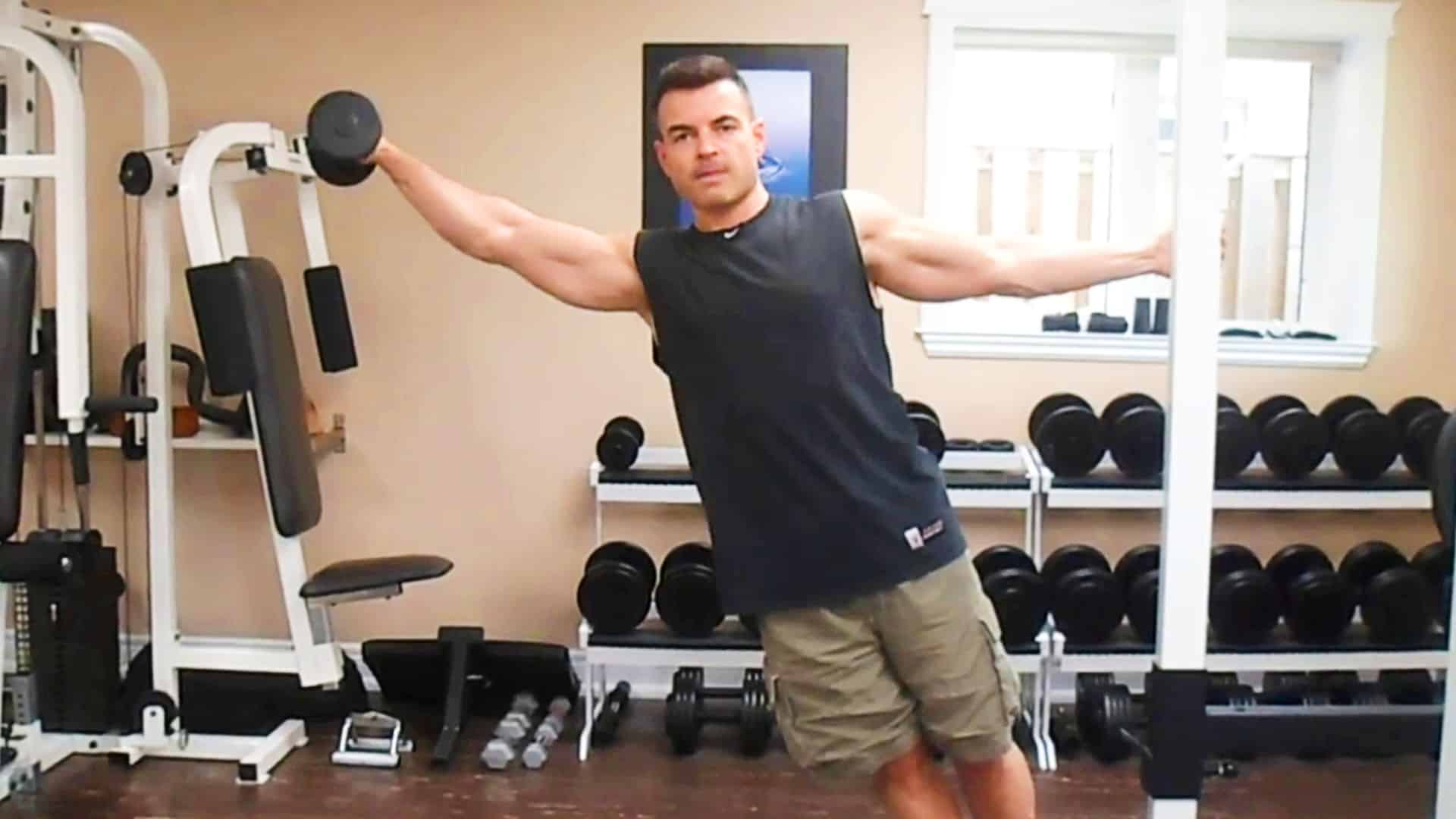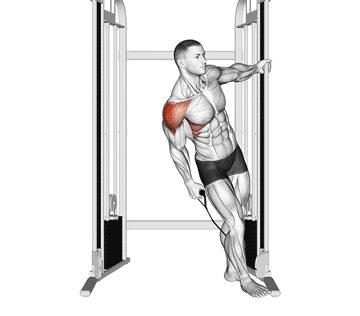If you’re looking for a way to target your shoulders, and core in one exercise, the leaning lateral raise is definitely worth adding to your workout routine.
Leaning away lateral raise strengthen the stabilizing muscles in your shoulders and improves your muscle balance.
Your shoulders are probably your most noticeable body part. Whether you are wearing a suit, t-shirt, or workout vest, good shoulders really stand out. Well-developed shoulders give your upper body its width and make you look powerful and strong.
In this blog post, we’ll explore the muscle worked during leaning lateral raise and provide step-by-step instructions on how to perform the exercise correctly.
We’ll also discuss how to incorporate the exercise into a full-body workout routine.

- Muscle Worked During Leaning Lateral Raise
- What Is Leaning Dumbbell Lateral Raise
- Why Choose Leaning Lateral Raise Over Traditional Lateral Raise?
- How To Do Leaning Dumbbell Lateral Raise
- Pro-Tips
- Variations of Leaning Lateral Raises
- 1. Leaning Cable Lateral Raise
- 2. Resistance Band Leaning Lateral Raise
- Benefits of the Leaning Lateral Raise
- 1. Strengthening and toning of the shoulders
- 2. Improve Core Strength
- 3. Improved sports performance
- 4. Better mind-muscle connection:
- 5. Variety in your workout routine
- Leaning Lateral Raise Alternative
- FAQs
- How many lateral raises should I do
- Leaning lateral raise vs lateral raise
- Takeaways
- Know More About Shoulder Training
- 15 Best Dumbbell Shoulder Exercises To Build Mass and Strength
Muscle Worked During Leaning Lateral Raise
The primary Muscle Worked during leaning away lateral raise is the lateral deltoid, (middle portion of the deltoid muscle)
Secondary Muscle Worked: The anterior deltoid, posterior deltoid, upper trap, supraspinatus (a rotator cuff muscle), and serratus anterior (muscles along your ribs under your armpit) also contribute to the movement.
A handful of other muscles worked or play the role of stabilizer muscles, including your
- Wrist flexors,
- Obliques, and
- Rectus abdominis.

What Is Leaning Dumbbell Lateral Raise
The leaning lateral raise, also called the leaning dumbbell raise, is a variation of the standard dumbbell lateral raise that provides a more challenging yet effective workout for strengthening the shoulders.
Compared with the dumbbell lateral raise, the leaning away dumbbell lateral raise puts your lateral deltoid under tension through a greater portion of the range of motion, making each repetition more effective.
The leaning position creates leverage while maximizing the isolation of the shoulders throughout the movement. It also places greater overload at the top of the movement.
To build the lateral head of the deltoid muscle, make leaning dumbbell lateral raise a part of your deltoid exercises.
Why Choose Leaning Lateral Raise Over Traditional Lateral Raise?
- Isolation: The leaning angle helps isolate the deltoids more than in the traditional lateral raise.
- Range of Motion: The leaning position may allow for a greater range of motion. It offers a deeper stretch and more intense contraction of the deltoid muscles.
- Variability: Adding a leaning component provides a new challenge and a way to add variability to your shoulder workouts.

How To Do Leaning Dumbbell Lateral Raise
- Stand holding a dumbbell with one hand, grasp anything stable with your free hand.
- Position both feet under the hand with which you are grasping the pole and lean out to the side holding the dumbbell, allowing the dumbbell to hang straight down.
- Flex your hips slightly so that you are leaning a little forward.
- Lift them to a point slightly higher than your shoulder.
- Now lower the dumbbell in a controlled manner back to the starting position.
- Perform all reps on one side and then repeat with the other arm.
Pro-Tips
- Pause for a moment at the top before slowly lowering the dumbbell back to the starting position.
- Keep a controlled motion and avoid jerky movements.
- Avoid arching of the lower back.
- If you have to swing the dumbbell, you are using too much weight and should reduce the load.
Variations of Leaning Lateral Raises
There are several ways to do the leaning lateral raise that will keep your workouts productive and interesting.
1. Leaning Cable Lateral Raise
Leaning away lateral raise exercise with cable machines provides constant tension and continuous resistance while lifting and lowering the weight.
The amount of muscle stretched during exercise is directly dependent on muscle growth and strength gains, so cable machines tire the muscles faster and provide greater strength gain.

How To Do Leaning Cable Lateral Raise
- Stand next to a cable pulley machine with the handle attachment adjusted to the lowest. With the outside arm, reach across your body, grab the handle and stand straight up with your arm fully extended and feet facing forward.
- Grip the machine with your inside arm for support. Now place your feet close to the pulley machine, allowing you to lean away from the machine.
- Maintaining a slight bend in your working elbow, raise your arm up to shoulder height.
- Then lower the weight back to the starting position.
- Repeat for the desired number of repetitions and repeat on the other side.
Pro-Tips
- This is an isolation exercise, so the focus should be on form and muscle contraction, not weight.
- Do not allow the handle to touch your body, and do not allow your body to move (or swing) throughout the movement.
- Keep your back straight and your head up. Keep your body still. Only your arm should move.
Know More: Cable Lateral Raises: How To Do, Muscle Worked & Alternates
2. Resistance Band Leaning Lateral Raise
The resistance band leaning lateral raise is a noteworthy variation of the lateral raise that can be performed with resistance bands in the comfort of one’s home.
Resistance band leaning lateral raise provides a unique strength curve that really overloads your medial deltoids.

How to Do
- Anchor band securely at shoulder height and stand inside loop.
- Feet shoulder-width, lean torso forward from hips. Engage core.
- Keeping a slight bend in elbows, raise arms out to the sides until parallel with the floor.
- Slowly return to the start position in controlled motion.
Tips
- Maintain upright posture, don’t arch back.
- Control movement on both eccentric and concentric.
- Keep elbows tucked in slightly, don’t let them flare out.
- Start with a lighter band and gradually increase the resistance as you become more comfortable.
Benefits of the Leaning Lateral Raise
Here are some potential benefits of the leaning lateral raise to build muscle and strength.
1. Strengthening and toning of the shoulders
The Leaning Lateral Raise targets the lateral deltoids, which are the muscles on the sides of the shoulders.
It improves your upper body strength and appearance.
2. Improve Core Strength
This exercise is performed while leaning sideways, which requires the core muscles to engage to maintain stability.
This can help to strengthen the abdominal muscles and improve your overall core strength and stability.
3. Improved sports performance
The Leaning lateral raise can be particularly beneficial for athletes who require upper body strength and stability for their sport.
By strengthening the shoulders, back, and core, this exercise can help to improve performance in sports like volleyball, basketball, and swimming.
4. Better mind-muscle connection:
It requires focus and concentration to perform correctly.
By strengthening your mind-muscle connection, you can improve your overall workout performance and get more out of your exercises.
5. Variety in your workout routine
It is a unique exercise that can add variety to your workout routine.
By mixing up your exercises, you can challenge your body in new ways and prevent boredom or plateaus in your progress.
Leaning Lateral Raise Alternative
Here’s an alternative exercise to the leaning lateral raise:
- Dumbbell one-arm lateral raise
- Cable Lateral Raise
- Arnold Shoulder Press
- Landmine Lateral Raise
- Y Raise
FAQs
How many lateral raises should I do
It’s recommended to perform 3–4 sets of 8–12 repetitions of lateral raises, with a weight that allows you to complete each set with good form and without excessive strain or fatigue.
Leaning lateral raise vs lateral raise
The leaning lateral raise is performed by leaning forward at the hips, holding a weight in one hand, and lifting the weight out to the side.
The opposite arm is placed on a bench or other support to maintain stability. This exercise engages the core muscles and provides a unique challenge to the lateral deltoids.
On the other hand, the Lateral raise is performed while standing upright, holding a weight in each hand or in one hand.
Takeaways
Dumbbell Leaning lateral raise is a challenging and effective exercise that targets the lateral deltoids and core muscles.
Additionally, leaning cable lateral raise variation can be a challenge because it uses a cable machine to increase muscle activation and tension throughout the movement.
It’s important to perform this exercise with proper form to achieve maximum benefits.
Know More About Shoulder Training
- Best Dumbbell Shoulder Exercises & Workouts For Mass
- Best Cable Shoulder Workout & Exercises for 3D Deltoids
- One Arm Cable Lateral Raise: How To Do & Muscle Worked
- Dumbbell Shoulder Fly: Muscles Worked, Benefits, Tips
- Different Shoulder Exercises Affect the Activation of Deltoid Portions in Resistance-Trained Individuals
15 Best Dumbbell Shoulder Exercises To Build Mass and Strength

Manish brings over 10 years of hands-on experience in weight lifting and fat loss to fitness coaching. He specializes in gym-based training and has a lot of knowledge about exercise, lifting technique, biomechanics, and more.
Through “Fit Life Regime,” he generously shares the insights he’s gained over a decade in the field. His goal is to equip others with the knowledge to start their own fitness journey.
